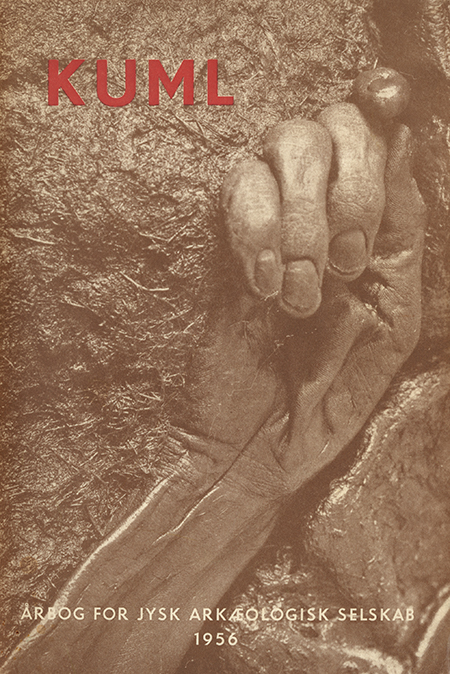Vindumhede-fletningerne og kjærlighetsknop
DOI:
https://doi.org/10.7146/kuml.v6i6.97290Keywords:
Vindumhede, Plait, fletning, magic knots, magiske knuder, Lovers knot, kærlighedsknudeAbstract
How and Why the Knot in the Vindumhede Plait was tied - and two Related Norwegian Knots
In ancient times and in the Middle Ages knots were believed to have magic or mystic power. Some examples of knots tied as a spell are given 1)2), and the Vindumhede plait (Fig. 13)) then examined. Assuming the Vindumhede knot to be a type of "lover's knot" (Kjærlighetsknop), the author describes the "lover's knot" from Vestfold (on the western shore of Oslo fiord) and the method of tying it (Fig. 2) as given by two Norwegian sailors. The example tied with one band is from AD 1900, and that with two bands from AD 1955.
Concerning the knot tied as in Fig. 2c one of the sailors informed the author:
In the 19th century young sailors often proposed marriage by tying a "kjærlighetsknop" in a red silk ribbon and sending it to the girl in the form shown in Fig. 2c. If she did not wish to accept the proposal she returned the ribbon untied. If, however, she wished to marry the suitor she tightened the knot and returned it in the form shown in Fig. 2d.
The tightened knot is the symbol of lasting love, and in that significance we find it in Gay's pastoral, "The Spell", (Fig. 2f5)), though in a very different form from the Norwegian "lover's knot".
In ancient votive offerings dedicated to a female deity we find the same knot as that of the Vindumhede plait (Fig. 13)) - and the similarity between this knot and the Norwegian lover's knot may perhaps permit the conclusion that the two are identical, both in shape and in purpose. There is an obvious difference, in so far as the Vindumhede knot is an offering to the goddess, whereas the "kjærlighetsknop" is a tie of love between a girl and a boy. But there is an underlying moment of erotic feeling in both.
The fragmentary remains of a very old custom survive in the northern districts of Gudbrandsdalen in Norway 6)7). They are temporally associated with Easter (Maundy Thursday and Good Friday). Young girls make plaits of wool which are called "Skjærtorsdagsdokka" or "Langfredagstråd" (Maundy-Thursday doll or Good-Friday skein), and boys of about 15-18 years of age go from farm to farm gathering the dolls, which they affix to their hats or jackets. They signify a sort of "tie of love" between the girl and the boy.
In his poem "Galkjøpe" (The Purchase of the Farm) the poet Engebret Hougen 6) appears in three lines to give an explanation of the hidden (and forgotten) purpose behind the custom:
The girl is plaiting her Maundy-Thursday doll, wondering whether she [herself or her doll] may be able to catch the eye of the boy to whom her heart aspires.
Her doll (the plait) seems to have an occult or magic purpose, a purpose which, of course, has nothing to do with Easter. Research has shown that the practice was originally a very old pre-Christian Christmas custom, secondarily transplanted to Easter 4). In its origin the custom had a colouring of fertility magic.
The first man to enter the room after Christmas when the spinning wheel is in use is called the "wheelman" (rokman), and the girl who is spinning is his "wheelwoman". The man's hair and beard are omens for the new year. Abundant long hair is an omen for good wool production in the coming year, while sparse hair forebodes bad production. The "wheelman" receives some of the wool from the wheel or a woollen plait as a gift from the "wheelvoman".
At a later stage the "wheelman" is transformed into a God or Goddess, who must, of course, receive their offerings - in this connection naturally the wool or plait. But by the 19th century all that is left of the custom is the boy (the final stage of the "wheelman") who collects his "skjærtorsdagsdokker" (Maundy-Thursday dolls).
Fig. 3 shows two specimens of "skjærtorsdagsdokker" plaited in AD 1955 by a peasant woman (in Sel, Gudbrandsdalen), who learnt the art of plaiting them from her mother.
Haakon Rougen
Downloads
Published
How to Cite
Issue
Section
License
Fra og med årgang 2022 er artikler udgivet i Kuml med en licens fra Creative Commons (CC BY-NC-SA 4.0).
Alle tidligere årgange af tidsskriftet er ikke udgivet med en licens fra Creative Commons.


